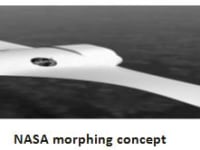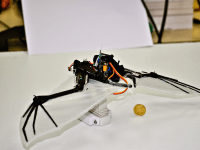Smart Materials to Improve Aerodynamic Efficiency
The morphing technology, inspired by bat and bird flight, can enable an aircraft to adapt its shape to enhance mission performance and optimize flight altitude controlling efficiency. Present day aircraft structure is greatly influenced by morphing at different points of time. Morphing indicates gradual change in the shape of any object by varying the cross section. It is achieved with the help of electrical actuators in the earlier scenario and gets upgraded with smart materials like Piezo-electric and shape memory alloys. Among the identified smart materials, Shape memory alloys have attracted a great interest by many researchers as a promising morphing wing material because of its shape recovery upon application of voltage. Shape memory concept refers the property of a material or an alloy which regains its original shape when external load or electrical energy is applied. The design possibilities in the field of aerospace engineering are advanced by the unique thermal and mechanical properties of shape memory alloys now a day to improve the aerodynamic efficiency. This paper presents the feasibility analyses of employing the shape memory alloy to modify the traditional flap in an aircraft wing.
The morphing concept is widely focusing on the adaptability of the aircraft to enable the optimized performance. This would make the aircraft to perform viable in fast and as well as in slow condition to work efficiently.Since from the wright brother concept, the morphing technology has adapted in large areas to increase the performance of the aircraft which work efficiently during each performance.Such ability has the potential of increasing the fuel, economy, mission adaptability, performance and flexibility. A more formal definition of a morphing air vehicle provided by DARPA (DEFENCE ADVANCED RESEARCH PROJECT AGENCY) that it uses a design that integrates innovative combination of advanced materials, actuator, flow controller, and mechanism to achieve the state change. This is done mainly due to the increase the adaptability, aerodynamic efficiency; eliminate the complex and heavy high lift device such as flaps etc., and its mechanisms.The types of morphing wings can be classified with regards to two purposes. The first one is to change the wing shape for the operating conditions or to improve the mobility. These morphing aircraft can perform multiple flight missions that are difficult to achieve using the fixed wing shape. The other one is to maximize the aerodynamic efficiency by substituting the section that causes aerodynamic losses.
The morphing air vehicles and associated technologies have the potential of introducing revolutionary developments to the aviation field. This will introduce the important improvement in the control mechanisms, performance, characteristics, fuel economics and weight of fixed wing airplanes. In considering the next century of flight, performance demands will likely continue to increase and even diversify. As with the dawn of powered of flight, it may be the dream and associated engineering curiosity that propels next leap. The morphing air vehicle will introduce revolutionary developments to aviation.
Keywords: Morphing technology, Electrical actuators, Piezo-electric, Shape memory alloys, Aerospace engineering, Flap.
Like this entry?
-
About the Entrant
- Name:Deepak Thomas Kallely
- Type of entry:individual
- Patent status:none








